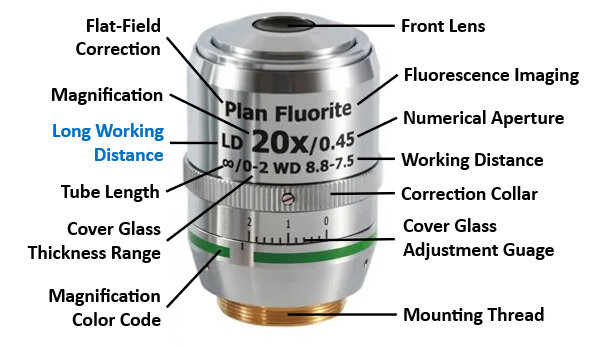Microscope Objectives, key facts you need to know.
Microscope Objectives, key facts you need to know.
Microscope objective lens is the front-end optical element that largely determines the quality of an imaging system. When selecting or comparing objectives, several key specifications describe its performance and suitability for a given application. The most important specifications you need to know:

1. Magnification
Definition: How many times the objective enlarges the specimen’s image relative to the object’s actual size (e.g., 4×, 10×, 40×, 100×).
Impact: Higher magnification reveals smaller features but usually narrows the field of view and reduces working distance.
2. Numerical Aperture (NA)
Definition: NA = n sin θ, where n is the refractive index of the medium between the lens and the sample, and θ is the half-angle of the light cone collected.
Impact: Governs resolving power and light-gathering ability.
Higher NA ⇒ better resolution and brightness.
Practical values range from about 0.1 (low-power dry) to 1.4+ (oil-immersion).
3. Working Distance (WD)
Definition: The distance from the front lens surface to the specimen when in focus.
Impact: Longer WD eases focusing on thick or uneven samples but often comes with lower NA.
4. Cover Glass Thickness / Correction
Definition: The thickness of the coverslip the objective is designed for, typically 0.17 mm for standard coverslips.
Variants: “No-cover” (for slide-free samples) or correction-collar objectives allow fine adjustment for different thicknesses.
5. Immersion Medium
Type: Air (dry), water, oil, glycerol, or silicone.
Impact: Matching the medium reduces refractive-index mismatch, enabling higher NA and better resolution for certain specimens.
6. Optical Corrections
Chromatic/Achromatic/Apochromatic: Describe how well the lens corrects color and spherical aberrations.
Achromat: Basic correction for two colors.
Fluor / Semi-apochromat: Improved color correction and higher NA.
Apochromat: Highest color and spherical correction.
7. Field Number & Field of View
Definition: Diameter of the image field the objective can illuminate without vignetting, influencing how much of the sample is visible.
8. Parfocal Distance / Mechanical Tube Length
Parfocal Distance: The distance from the mounting shoulder to the focal plane, standardized (e.g., 45 mm) so objectives can be swapped without major refocusing.
Tube Length: Finite (e.g., 160 mm) or infinity-corrected objectives require matching microscope optics.
9. Transmission and Coatings
Anti-reflection coatings optimize transmission for specific wavelength ranges—important for fluorescence or IR imaging.
10. Special Features
Phase contrast rings, DIC prisms, or long-working-distance (LWD) designs tailored to specific imaging modalities.



